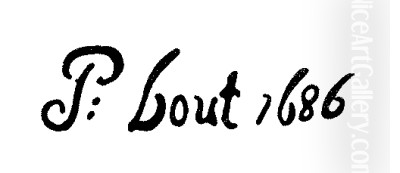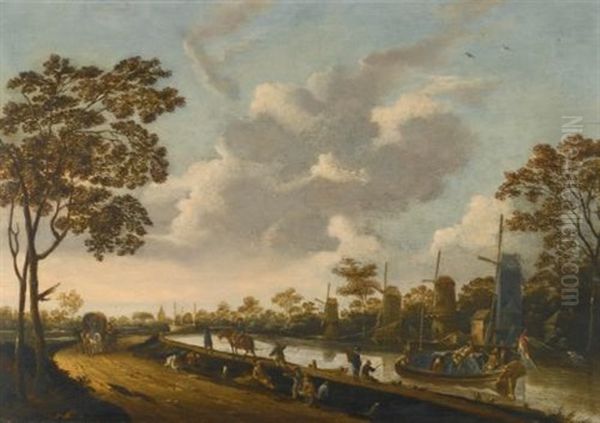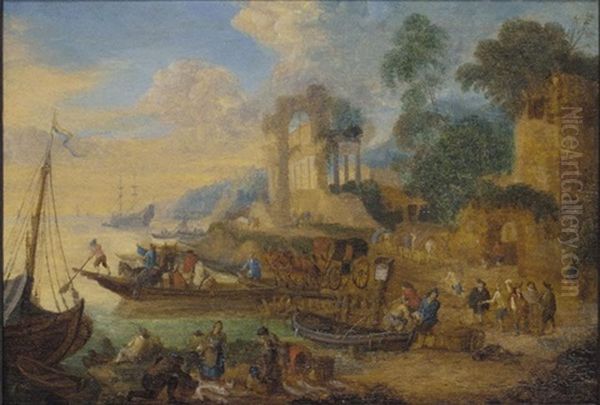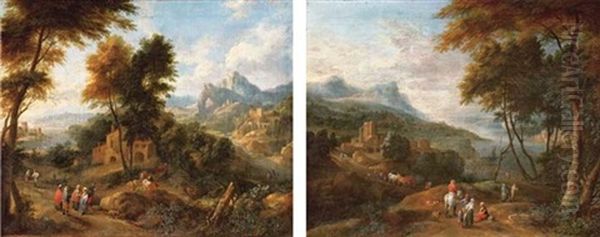
Pieter Bout stands as a notable figure in the landscape of Flemish Baroque art. Active primarily during the latter half of the seventeenth and the early eighteenth centuries, Bout carved a niche for himself through his detailed and lively depictions of the world around him. Born likely around 1658 in Brussels, and buried there in August 1719, his life spanned a period of transition in the Southern Netherlands, yet his work often retained a vibrant connection to established Flemish traditions while incorporating contemporary trends. He was a painter and draughtsman known especially for his landscapes, cityscapes, coastal scenes, and the animated figures that populated them.
Bout's artistic identity is strongly linked to the city of Brussels, which remained his primary base throughout his career. While specific details about his early training remain elusive, a common situation for many artists of his time, it is clear he emerged as a skilled painter within the city's active artistic community. Brussels, though perhaps lacking the overwhelming dominance Antwerp held earlier in the century, was still a significant center for tapestry production, sculpture, and painting, fostering a distinct local school.
The Artistic Environment and Influences
The artistic milieu Bout entered was rich with tradition. Flemish landscape painting had a long and distinguished history, stretching back to pioneers like Joachim Patinir and evolving through the monumental contributions of Pieter Bruegel the Elder. Bout's work clearly shows an affinity with the detailed, narrative-rich tradition exemplified by Jan Brueghel the Elder, often called 'Velvet' Brueghel. The meticulous rendering of figures, architecture, and natural elements, along with a penchant for bustling, populated scenes, echoes the Brueghelian legacy.
Furthermore, the influence of prominent genre painters, particularly David Teniers the Younger, can be discerned in Bout's lively depiction of peasants, market-goers, and individuals engaged in everyday activities or festivities. Teniers had set a high standard for capturing the character and energy of rural and village life, an aspect Bout incorporated into his own landscape and urban settings.

Another significant current in seventeenth-century Flemish art was the influence of Italy. Many artists travelled south, while others absorbed Italianate ideas through prints or the work of returned colleagues. While it's not definitively documented whether Bout himself travelled to Italy, his works frequently incorporate architectural elements like classical ruins, Mediterranean-style buildings, arcades, and bustling harbour scenes that evoke Italian ports. This suggests an awareness of, and engagement with, the popular Italianate landscape style mastered by artists like Jan Both and Nicolaes Berchem, whose works often featured warm light and picturesque scenery. Bout skillfully blended these southern motifs with his inherent Flemish realism.
A contemporary who worked in a somewhat similar vein, often looking back to the Brueghel tradition while depicting detailed landscapes and genre scenes, was Joseph van Bredael. Both artists contributed to the continuing demand for cabinet-sized paintings filled with intricate detail and engaging subject matter.
Collaboration: A Defining Feature
One of the most defining aspects of Pieter Bout's career was his frequent collaboration with other artists, a common practice in the specialized art market of the Low Countries. His most significant and well-documented partnership was with Adriaen Frans Boudewyns (1644–1711). Boudewyns, himself a respected landscape painter and etcher, often created the landscape settings, while Bout specialized in adding the 'staffage' – the human figures and animals that brought the scenes to life.
This division of labour allowed each artist to focus on their strengths, resulting in works that combined Boudewyns's atmospheric landscapes with Bout's talent for lively, detailed figures. Their collaborative paintings often depict elegant companies enjoying the countryside, travellers on roads, or villagers near rivers and forests. Records suggest this partnership was particularly active around the 1670s, possibly including time spent working together in Paris, although Bout's primary base remained Brussels.
Bout's skill in figure painting was clearly in demand, as evidence suggests he also collaborated with other prominent Brussels landscape painters. Sources mention partnerships with Lucas Achtschellinck, a painter known for his large-scale forest landscapes in the tradition of Jacques d'Arthois, and potentially with d'Arthois himself. In these collaborations, Bout would again provide the figures, adding narrative interest and scale to the expansive natural settings created by his colleagues. This practice highlights the interconnectedness of the Brussels art scene and Bout's reputation as a reliable specialist. Such collaborations were economically efficient and allowed for the production of high-quality works appealing to diverse tastes.
A Diverse Subject Range
Pieter Bout demonstrated considerable versatility in his choice of subjects, moving fluidly between different types of landscape and genre scenes. His oeuvre reflects the varied tastes of the contemporary art market.

River and Canal Landscapes: Many of Bout's works feature tranquil river or canal scenes, often depicting the flat, watery terrain typical of the Low Countries. These paintings frequently include barges being pulled along towpaths, small boats navigating the waterways, and picturesque villages nestled among trees on the banks. A fine example is his Landscape with Barges being Towed along a Canal, dated 1683. These works combine careful observation of nature with charming depictions of human activity, linking them to the Dutch landscape tradition of artists like Jan van Goyen, but imbued with a distinctly Flemish figurative style.
Urban Scenes and Markets: Bout excelled at capturing the vibrant energy of urban life. He painted bustling market squares, often set against impressive architectural backdrops featuring churches, town halls, and houses. These scenes teem with activity: vendors selling their wares, shoppers milling about, children playing, and carriages passing through. His Busy Market Square exemplifies this genre, showcasing his ability to orchestrate large numbers of figures into a coherent and engaging composition. While sometimes depicting specific locations, many scenes offer a generalized yet convincing portrayal of Flemish town life, comparable in theme, if different in style, to the city views of Dutch painters like Gerrit Berckheyde.
Winter Landscapes: Following a tradition popularized by Pieter Bruegel the Elder and continued by Hendrick Avercamp, winter scenes were a beloved genre in the Low Countries. Bout contributed numerous paintings depicting frozen rivers and canals alive with skaters, sleighs, and figures enjoying the cold weather. His Harsh Winter Scene with Skaters captures the crisp atmosphere and communal activities associated with winter, rendered with his characteristic attention to detail and lively figure drawing.
Coastal and Harbour Views: Reflecting the Italianate influences mentioned earlier, Bout also painted coastal and harbour scenes. These often feature more dramatic settings than his inland landscapes, sometimes incorporating fantastical or Mediterranean-style architecture, busy ports filled with ships, and diverse crowds including merchants, sailors, and travellers. Works like Harbour with a Walled Town blend Flemish painting techniques with exotic locales. A particularly intriguing example is An Ottoman Official Arriving at a Mediterranean Port, which demonstrates his willingness to tackle more unusual, orientalist themes, catering to a taste for the exotic.
Signature Style: Detail and Vivacity
Across his diverse subjects, Bout maintained a consistent stylistic approach characterized by meticulous detail and a sense of lively animation. He typically employed fine brushwork, allowing for the precise rendering of clothing, architectural features, foliage, and the small narrative incidents occurring within his scenes. His figures, though often small in scale relative to the overall landscape or cityscape, are individually characterized and grouped dynamically.

His colour palette is generally bright and varied, contributing to the cheerful and engaging atmosphere of many of his works. He possessed a strong ability to integrate numerous figures seamlessly into their surroundings, creating compositions that are both complex and harmonious. This dedication to detail and lively narrative connects his work back to the enduring legacy of the Brueghel family, particularly Jan Brueghel the Elder, adapting that tradition for the tastes of the late seventeenth and early eighteenth centuries.
Bout and the Guild of Saint Luke
Pieter Bout was an established member of the Brussels artistic community, formally recognized by the Guild of Saint Luke. Records indicate he was registered as a master in the Brussels guild in 1671/72, signifying his official status as an independent artist qualified to take on pupils and sell his work. Guild membership was crucial for artists, providing a framework for training, quality control, and professional association.
Further evidence of his standing within the guild comes from a mention, noted in the source material provided, of him serving as a director of the guild in 1716. This position would indicate significant respect among his peers late in his career. His participation in the guild placed him alongside other significant Brussels artists of the period, including the landscape painters he collaborated with, such as Adriaen Frans Boudewyns, Lucas Achtschellinck, and Jacques d'Arthois, as well as others like Cornelis Huysmans.
Later Years and Legacy
Pieter Bout remained active into the early eighteenth century, continuing to produce the detailed landscapes and genre scenes for which he was known. His works evidently found a ready market during his lifetime and continued to be appreciated thereafter. The appearance of his paintings, or works attributed to his circle, in auctions centuries later, sometimes fetching considerable prices (as noted by the sale of a Circle of Pieter Bout work in 2010), attests to a lasting appeal.
However, as noted in some assessments, the sheer volume of work produced, potentially involving workshop assistance or followers imitating his popular style, may have led to variations in quality. Attribution issues can sometimes arise with prolific artists or those who worked extensively in collaboration. This, combined with the fact that Brussels artists of this period are sometimes overshadowed in art history by their Antwerp or Dutch contemporaries, might contribute to why Bout is not always given the prominence his skill might warrant.

Despite this, Pieter Bout remains a significant figure in late Flemish Baroque painting. He was a highly skilled and versatile painter, adept at capturing the landscapes and daily life of his time with remarkable detail and vivacity. His collaborations, particularly with Boudewyns, produced distinctive works that merge different artistic specializations. His paintings offer valuable and charming visual records of the Southern Netherlands, infused with influences from both local tradition and broader European trends like the Italianate style. He stands as a key representative of the Brussels school of painting during his era, and his works continue to be admired for their craftsmanship and engaging depictions of a bygone world. His contribution is evident in the collections of numerous museums and private collections where his detailed views continue to delight observers.